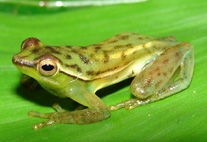Abstract
A new species of Sphaenorhynchus is described from the Municipality of Mariana, State of Minas Gerais, Brazil. It is characterized by the vocal sac moderately developed, single, subgular, with longitudinal folds; white canthal and dorsolateral lines delimited below by a dorsolateral black line from the tip of snout extending beyond the eye to gradually disappearing up to the flanks; and premaxilla and maxilla almost completely edentulous, each bearing 1–5 extremely small teeth. It is most similar with Sphaenorhynchus orophilus, from which it can be distinguished by having a less robust forearm in males; glandular subcloacal dermal fold; premaxilla and maxilla almost completely edentulous; and larvae with large marginal papillae in the oral disc. The new species occurs in natural ponds over ironstone outcrops (known as canga) on flat terrain, where males call from the floating vegetation.

